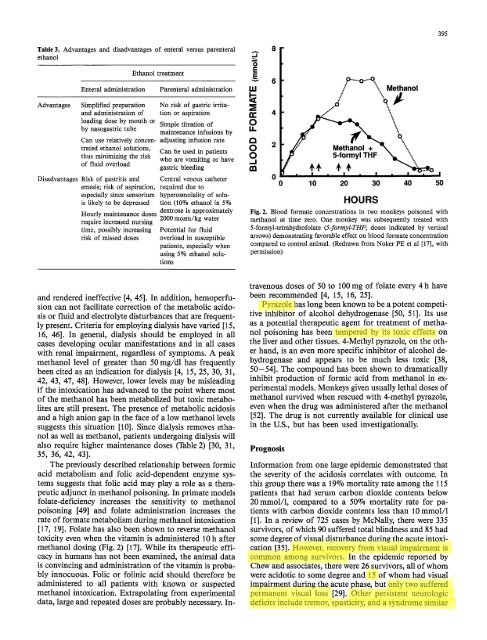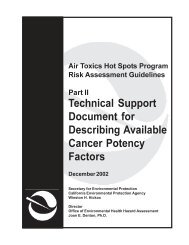Methanol poisoning - While Science Sleeps
Methanol poisoning - While Science Sleeps
Methanol poisoning - While Science Sleeps
You also want an ePaper? Increase the reach of your titles
YUMPU automatically turns print PDFs into web optimized ePapers that Google loves.
395<br />
Table 3. Advantages and disadvantages of enteral versus parenterai<br />
ethanol<br />
Advantages<br />
Disadvantages<br />
Enteral administration<br />
Ethanol treatment<br />
Parenterai administration<br />
Simplified preparation No risk of gastric irritaand<br />
administration of tion or aspiration<br />
loading dose by mouth or<br />
Simple titration of<br />
by nasogastric tube<br />
maintenance infusions by<br />
Can use relatively concen- adjusting infusion rate<br />
trated ethanol solutions,<br />
Can be used in patients<br />
thus minimizing the risk<br />
who are vomiting or have<br />
of fluid overload<br />
gastric bleeding<br />
Risk of gastritis and<br />
emesis; risk of aspiration,<br />
especially since sensorium<br />
is likely to be depressed<br />
Hourly maintenance doses<br />
require increased nursing<br />
time, possibly increasing<br />
risk of missed doses<br />
Central venous catheter<br />
required due to<br />
hyperosmolality of solution<br />
(10% ethanol in 5%<br />
dextrose is approximately<br />
2000 mosm/kg water<br />
Potential for fluid<br />
overload in susceptible<br />
patients, especially when<br />
using 5% ethanol solutions<br />
A<br />
--I<br />
m<br />
O<br />
E<br />
E<br />
I.U<br />
=Z<br />
n-<br />
O<br />
IJ.<br />
o<br />
O<br />
_1<br />
m<br />
8<br />
6<br />
4<br />
2<br />
I<br />
/<br />
p"...o.-"~<br />
/ -- <strong>Methanol</strong><br />
0<br />
0 10 20 30 40<br />
HOURS<br />
Fig. 2. Blood formate concentrations in two monkeys poisoned with<br />
methanol at time zero. One monkey was subsequently treated with<br />
5-formyl-tetrahydrofolate (5-formyl-THF; doses indicated by vertical<br />
arrows) demonstrating favorable effect on blood formate concentration<br />
compared to control animal. (Redrawn from Noker PEet al [17], with<br />
permission)<br />
!<br />
5O<br />
and rendered ineffective [4, 45]. In addition, hemoperfusion<br />
can not facilitate correction of the metabolic acidosis<br />
or fluid and electrolyte disturbances that are frequently<br />
present. Criteria for employing dialysis have varied [15,<br />
16, 46]. In general, dialysis should be employed in all<br />
cases developing ocular manifestations and in all cases<br />
with renal impairment, regardless of symptoms. A peak<br />
methanol level of greater than 50 mg/dl has frequently<br />
been cited as an indication for dialysis [4, 15, 25, 30, 31,<br />
42, 43, 47, 48]. However, lower levels may be misleading<br />
if the intoxication has advanced to the point where most<br />
of the methanol has been metabolized but toxic metabolites<br />
are still present. The presence of metabolic acidosis<br />
and a high anion gap in the face of a low methanol levels<br />
suggests this situation [10]. Since dialysis removes ethanol<br />
as well as methanol, patients undergoing dialysis will<br />
also require higher maintenance doses (Table 2) [30, 31,<br />
35, 36, 42, 43].<br />
The previously described relationship between formic<br />
acid metabolism and folic acid-dependent enzyme systems<br />
suggests that folic acid may play a role as a therapeutic<br />
adjunct in methanol <strong>poisoning</strong>. In primate models<br />
folate-deflciency increases the sensitivity to methanol<br />
<strong>poisoning</strong> [49] and folate administration increases the<br />
rate of formate metabolism during methanol intoxication<br />
[17, 19]. Folate has also been shown to reverse methanol<br />
toxicity even when the vitamin is administered 10 h after<br />
methanol dosing (Fig. 2) [17]. <strong>While</strong> its therapeutic efficacy<br />
in humans has not been examined, the animal data<br />
is convincing and administration of the vitamin is probably<br />
innocuous. Folic or folinic acid should therefore be<br />
administered to all patients with known or suspected<br />
methanol intoxication. Extrapolating from experimental<br />
data, large and repeated doses are probably necessary. In-<br />
travenous doses of 50 to 100 mg of folate every 4 h have<br />
been recommended [4, 15, 16, 25].<br />
Pyrazole has long been known to be a potent competitive<br />
inhibitor of alcohol dehydrogenase [50, 51]. Its use<br />
as a potential therapeutic agent for treatment of methanol<br />
<strong>poisoning</strong> has been tempered by its toxic effects on<br />
the liver and other tissues. 4-Methyl pyrazole, on the other<br />
hand, is an even more specific inhibitor of alcohol dehydrogenase<br />
and appears to be much less toxic [38,<br />
50-54]. The compound has been shown to dramatically<br />
inhibit production of formic acid from methanol in experimental<br />
models. Monkeys given usually lethal doses of<br />
methanol survived when rescued with 4-methyl pyrazole,<br />
even when the drug was administered after the methanol<br />
[52]. The drug is not currently available for clinical use<br />
in the U.S., but has been used investigationally.<br />
Prognosis<br />
Information from one large epidemic demonstrated that<br />
the severity of the acidosis correlates with outcome. In<br />
this group there was a 19% mortality rate among the 115<br />
patients that had serum carbon dioxide contents below<br />
20 mmol/1, compared to a 50% mortality rate for patients<br />
with carbon dioxide contents less than 10 mmol/l<br />
[1]. In a review of 725 cases by McNally, there were 335<br />
survivors, of which 90 suffered total blindness and 85 had<br />
some degree of visual disturbance during the acute intoxication<br />
[35]. However, recovery from visual impairment is<br />
common among survivors. In the epidemic reported by<br />
Chew and associates, there were 26 survivors, all of whom<br />
were acidotic to some degree and 15 of whom had visual<br />
impairment during the acute phase, but only two suffered<br />
permanent visual loss [29]. Other persistent neurologic<br />
deficits include tremor, spasticity, and a syndrome similar







